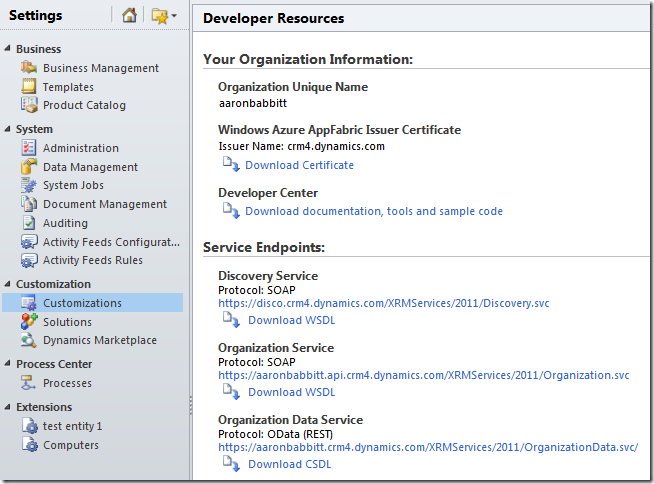原创地址:http://www.cnblogs.com/jfzhu/admin/EditPosts.aspx?postid=2752006
转载请注明出处
本文要讲解,在CRM应用之外,不具有CRM context的情况下,如何连接到CRM,获得CRM的相关数据。如果你有耐心的话,也可以仔细研究一下SDK中Sample: Simplified Connection Quick Start using Microsoft Dynamics CRM 2011 and Microsoft Dynamics CRM Online。
CRM 2011提供了一个Assembly microsoft.xrm.client.dll,如果从客户端连接CRM的话,可以使用该Assembly中的OrganizationService类。我在本文中以一个控制台程序来演示如何连接到CRM 2011。首先程序需要使用到的引用如下图。有关CRM的引用都可以在sdk的bin文件夹中找到。
Program.cs的代码为:
using System; using Microsoft.Xrm.Client.Services; using Microsoft.Xrm.Client; using Microsoft.Crm.Sdk.Messages; using System.ServiceModel; using System.Configuration; using Microsoft.Xrm.Sdk; using Microsoft.Xrm.Sdk.Query; namespace ConsoleApplication3 { public class SimplifiedConnection { #region Class Level Members private OrganizationService _orgService; #endregion Class Level Members public void Run(String connectionString, bool promptforDelete) { try { // Establish a connection to the organization web service using CrmConnection. Microsoft.Xrm.Client.CrmConnection connection = CrmConnection.Parse(connectionString); // Obtain an organization service proxy. // The using statement assures that the service proxy will be properly disposed. using (_orgService = new OrganizationService(connection)) { // Obtain information about the logged on user from the web service. Guid userid = ((WhoAmIResponse)_orgService.Execute(new WhoAmIRequest())).UserId; Entity systemUser = _orgService.Retrieve("systemuser", userid, new ColumnSet(new string[] { "firstname", "lastname" })); Console.WriteLine("Logged on user is {0} {1}.", systemUser["firstname"].ToString(), systemUser["lastname"].ToString()); } } // Catch any service fault exceptions that Microsoft Dynamics CRM throws. catch (FaultException<Microsoft.Xrm.Sdk.OrganizationServiceFault>) { // You can handle an exception here or pass it back to the calling method. throw; } } #region Public Methods #endregion Public Methods #region Private Methods /// <summary> /// Gets web service connection information from the app.config file. /// If there is more than one available, the user is prompted to select /// the desired connection configuration by name. /// </summary> /// <returns>A string containing web service connection configuration information.</returns> private static String GetServiceConfiguration() { var connection = ConfigurationManager.ConnectionStrings["CrmConnection"]; return connection.ConnectionString; } #endregion Private Methods #region Main method /// <summary> /// Standard Main() method used by most SDK samples. /// </summary> /// <param name="args"></param> static public void Main(string[] args) { try { // Obtain connection configuration information for the Microsoft Dynamics // CRM organization web service. String connectionString = GetServiceConfiguration(); if (connectionString != null) { SimplifiedConnection app = new SimplifiedConnection(); app.Run(connectionString, true); } } catch (FaultException<Microsoft.Xrm.Sdk.OrganizationServiceFault> ex) { Console.WriteLine("The application terminated with an error."); Console.WriteLine("Timestamp: {0}", ex.Detail.Timestamp); Console.WriteLine("Code: {0}", ex.Detail.ErrorCode); Console.WriteLine("Message: {0}", ex.Detail.Message); Console.WriteLine("Trace: {0}", ex.Detail.TraceText); Console.WriteLine("Inner Fault: {0}", null == ex.Detail.InnerFault ? "Has Inner Fault" : "No Inner Fault"); } catch (System.TimeoutException ex) { Console.WriteLine("The application terminated with an error."); Console.WriteLine("Message: {0}", ex.Message); Console.WriteLine("Stack Trace: {0}", ex.StackTrace); Console.WriteLine("Inner Fault: {0}", null == ex.InnerException.Message ? "Has Inner Fault" : "No Inner Fault"); } catch (System.Exception ex) { Console.WriteLine("The application terminated with an error."); Console.WriteLine(ex.Message); // Display the details of the inner exception. if (ex.InnerException != null) { Console.WriteLine(ex.InnerException.Message); FaultException<Microsoft.Xrm.Sdk.OrganizationServiceFault> fe = ex.InnerException as FaultException<Microsoft.Xrm.Sdk.OrganizationServiceFault>; if (fe != null) { Console.WriteLine("Timestamp: {0}", fe.Detail.Timestamp); Console.WriteLine("Code: {0}", fe.Detail.ErrorCode); Console.WriteLine("Message: {0}", fe.Detail.Message); Console.WriteLine("Trace: {0}", fe.Detail.TraceText); Console.WriteLine("Inner Fault: {0}", null == fe.Detail.InnerFault ? "Has Inner Fault" : "No Inner Fault"); } } } // Additional exceptions to catch: SecurityTokenValidationException, ExpiredSecurityTokenException, // SecurityAccessDeniedException, MessageSecurityException, and SecurityNegotiationException. finally { Console.WriteLine("Press <Enter> to exit."); Console.ReadLine(); } } #endregion Main method } }
上面的程序需要从配置文件读取ConnectionString。一个范例app.config文件如下所示。
<?xml version="1.0"?> <configuration> <connectionStrings> <!-- Online using Office 365 --> <!-- <add name="CrmConnection" connectionString="Url=https://contoso.crm.dynamics.com; Username=someone@contoso.onmicrosoft.com; Password=password;"/> --> <!-- Online using Windows Live ID --> <add name="CrmConnection" connectionString="Url=https://aaronbabbitt.api.crm4.dynamics.com/XRMServices/2011/Organization.svc; Username=username@aaronbabbitt.onmicrosoft.com; Password=password; DeviceID=11hfn41bbqrg580vyvoea05abc; DevicePassword=fuqNIlx%e$.l*+ax_#8O4abc;"/> <!--On-premises with provided user credentials--> <!--<add name="CrmConnection" connectionString="Url=http://servername/orgname; Domain=domainname; Username=username; Password=password;"/>--> <!-- On-premises using Windows integrated security --> <!--<add name="CrmConnection" connectionString="Url=http://servername/orgname;"/>--> <!-- On-Premises (IFD) with claims --> <!--<add name="CrmConnection" connectionString="Url=https://url.xxx/XRMServices/2011/Organization.svc; Username=username@xxx.local; Password=password;"/>--> </connectionStrings> <startup> <supportedRuntime version="v4.0" sku=".NETFramework,Version=v4.0"/> </startup> </configuration>
这段代码完成的事情很简单,就是使用OrganizationService类来执行一个WhoAmIRequest。如果成功就表示控制台成功连接到了CRM。配置文件中一共有5个connection string 的样例。分别用来连接:
(1) 使用Office 365 ID 的 CRM Online;
(2) 使用Windows Live ID的 CRM Online;
(3) CRM On-Premises;
(4)CRM On-Premises,使用当前Windows integrated security来登录,所以不需要提供用户密码;
(5) 使用了IFD的CRM On-Premises。
上面除了(1)我没有进行测试,其他四种CRM都通过了该段代码的测试。在Connection String中,对于CRM Online和IFD On-Premises,URL需要使用Organization Service 的 URL。要查看CRM的Organization Service的URL,可以在Settings –> Customization –> Customizations –> Developer Resources中查看
连接CRM Online的时候,需要DeviceID和DevicePassword。很多人不懂DeviceID是干什么用的。DeviceID的目的就是注册一个设备,使这个设备可以使用Windows Live ID。当你注册了这个设备后,任何用户就都可以使用这个设备了。所以如果这个是一个从未注册过的设备,你首先要注册它。关于如何注册一个设备,可以使用sdk带的deviceregistration工具。具体的命令是DeviceRegistration.exe /operation:Register。命令运行成功后,你就可以拷贝生成的Device ID和Device Password了。
最后再说一下,因为在配置文件中,我们保存了用户登录信息,这样很容易泄露用户名和密码,所以我再说一下如何对配置文件的Connection string进行加密。对配置文件加密可以使用aspnet_regiis.exe工具,Visual Studio自带这个工具。如果没有Visual Studio,.Net中也包含了这个工具。可以在%windows root directory%\Microsoft.NET\%Framework\%version 中找到该工具。首先将app.config另存为文件名为web.config的文件,假如我将该文件保存到我的C:\temp目录中。文件的内容为:
<?xml version="1.0"?> <configuration> <connectionStrings> <!-- Online using Windows Live ID --> <add name="CrmConnection" connectionString="Url=https://aaronbabbitt.api.crm4.dynamics.com/XRMServices/2011/Organization.svc; Username=username@aaronbabbitt.onmicrosoft.com; Password=password; DeviceID=11hfn41bbqrg580vyvoea05abc; DevicePassword=fuqNIlx%e$.l*+ax_#8O4abc;"/> </connectionStrings> <startup> <supportedRuntime version="v4.0" sku=".NETFramework,Version=v4.0"/> </startup> </configuration>
运行命令 aspnet_regiis -pef "connectionStrings" "C:\temp",打开web.config文件,发现加密后的内容为:
<?xml version="1.0"?> <configuration> <connectionStrings configProtectionProvider="RsaProtectedConfigurationProvider"> <EncryptedData Type="http://www.w3.org/2001/04/xmlenc#Element" xmlns="http://www.w3.org/2001/04/xmlenc#"> <EncryptionMethod Algorithm="http://www.w3.org/2001/04/xmlenc#tripledes-cbc" /> <KeyInfo xmlns="http://www.w3.org/2000/09/xmldsig#"> <EncryptedKey xmlns="http://www.w3.org/2001/04/xmlenc#"> <EncryptionMethod Algorithm="http://www.w3.org/2001/04/xmlenc#rsa-1_5" /> <KeyInfo xmlns="http://www.w3.org/2000/09/xmldsig#"> <KeyName>Rsa Key</KeyName> </KeyInfo> <CipherData> <CipherValue>ll2Y+mC2QlqQ/xhj4jpTu4IQwYVoXjJ7ZVomJvWTtfo5f1o8N46lEPED5Z8k4RrSoJWlk2CKsmxIW8Y5soBlsckEe8ZAGfAHezynUXI1X3QNXLX7qm6F2A7NPuZxpEjKv1JEWOKpTxwo3MMXZwiKjuw3e/puOqKYsrfqT+wHK1E=</CipherValue> </CipherData> </EncryptedKey> </KeyInfo> <CipherData> <CipherValue>1+ugw1BnAfPhQW3AXtWnjn+KjYFdD4xz56ue8RFjATaNw0HbdyoYm4F+R1zKQP7iqWIebD/gNoYNARFiF7BwHtgOO+7nJsSzkH5i6FgkNaJtvIPUMK7dXF9kCbXEB1MGmnSnjgb8AHhvy68k+Ib1HuWeSvlRDzHuLAOWQ4iM6+Impdcoe27Rs02tRs3a/Jy0NPFhUS+Ps0tTsMJQO5uztcjPbmaNx/jOoxHWaUDWpSx7ucaOK1p/Ko4aN29W1y7iCvvi0wFAOXPi1oega5qSXFnyIADekuPRXxM1vNvKHXBuemxslqtNfazTeY/NxkJ/qRYUbPfdxJRk2MaBZtPOS57nqTWxiRGQJtsUliw4Y0x8sfj/wO0/aDD7T/zFVOj9Ayk15bTNQ2Kpu8qM+DpiUkg/I6l0HDDYz1BZlgItGEjykDjgE6QrB6Woq+svAukEt7bbCitdPPSbliE7d1lxw6VktjQ9/3A1</CipherValue> </CipherData> </EncryptedData> </connectionStrings> <startup> <supportedRuntime version="v4.0" sku=".NETFramework,Version=v4.0"/> </startup> </configuration>
然后你可以将该内容拷贝到你的app.config文件中去。
解密的命令为aspnet_regiis -pef "connectionStrings" "C:\temp"。当然解密与加密必须是在同一电脑上进行的,如果某个恶意用户获取了你加密后的app.config文件,在他自己的电脑上运行该命令是无法解密该文件的。
总结:从CRM外部连接CRM,可以使用上面的CRM“万能”连接程序,基本上各种deployment方式的CRM,都可以使用它来连接。该程序使用了Assembly microsoft.xrm.client.dll中的OrganizationService类。你需要在app.config或web.config中配置connection string。最后基于安全性,要对配置文件的connectionStrings section进行加密。加密可以使用aspnet_regiis 工具。



